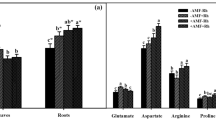Summary
Foliar sprays of growth regulators brought forth attendant changes in the rhizosphere of pigeon pea (Cajanus cajan Millsp.). Sprays of NAA boosted up fungi in the rhizosphere, regardless of its concentration and age of the plants. Significant increases in bacterial numbers were recorded in the rhizosphere of 2,4-D-treated plants and this effect was again independent of the concentration employed and the age levels. Gibberellin and MH sprays generally lowered microbial numbers in the rhizosphere. Reductions in microbial numbers with MH sprays were not necessarily apparent when combined with other growth regulators.
Similar content being viewed by others
References
Agnihothrudu, V., Soil conditions and root diseases VIII. Rhizosphere microflora of some of the important crop plants of South India. Proc. Indian Acad. Sci.37B, 1–13 (1953).
Audus, L. J., Herbicide behaviour in the soil. II. Interactions with soil micro-organisms.In: The Physiology and Biochemistry of Herbicides. Chapter V, pp. 163–206, Academic Press (1964).
Ciferri, O. and Bertossi, F., Gibberellic acid and the growth of some micro-organisms. Bull. Soc. Ital. Biol. Ser.33, 114 (1957).
Crafts, A. S., Herbicide behaviour in the plant.In: The Physiology and Biochemistry of Herbicides. Chapter III, pp. 75–110. Academic Press (1964).
Eliasson, L., Responses of aspen roots to auxin-type growth substances applied to the leaves. Physiol. Plantarum16, 201–204 (1963).
Hay, J. R. and Thimann, K. V., The fate of 2,4-dichlorophenoxyacetic acid in bean seedlings. I. Recovery of 2,4-dichlorophenoxyacetic acid and its breakdown in the plant. Plant Physiol.31, 382–387 (1956).
Lakshmi-Kumari, M., Rhizosphere Microfloras and Host-Parasite Relationships. Ph.D. Thesis. Madras University (1961).
Levi, E. and Crafts, A. S., Toxicity of maleic hydrazide in California soils. Hilgardia21, 431–463 (1952).
Magee, L. A., Responses of soil microorganisms to sodium 2,2-dichloropropionate and maleic hydrazide diethanolamine. Diss. Abstracts19, 413–414 (1958).
McComb, A. J., The Movement of Gibberellic Acid in Pea Seedlings. Ph.D. Thesis, Cambridge (1962). Quoted by Carr, D. J., Reid, D. M. and Skene, K. G. M., Planta63, 382–392.
McComb, A. J., The stability and movement of gibberellic acid in pea seedlings. Ann. Botany28, 669–687 (1964).
Mitchell, J. W., Linder, P. J., and Robinson, M. B., Mechanism of root exudation of α-methoxyphenyl acetic acid in the bean plant. Bot. Gaz.123, 134–140 (1961).
Newman, A. S. and Downing, C. E., Herbicides and the soil. J. Agric. Food Chem.6, 352–353 (1958).
Nickell, L. G. and English, A. R., Effect of maleic hydrazide on soil bacteria and other microorganisms. Weeds2, 190–195 (1953).
Phinney, B. O. and West, C. A., Gibberellins as native plant growth regulator. Ann. Rev. Plant Physiol.11, 411–436 (1960).
Ramachandra-Reddy, T. K., Studies on Soil Fungi. Ph.D. Thesis. Madras University (1960).
Rovira, A. D., Interactions between plant roots and soil micro-organisms. Ann. Rev. Microbiol.19, 241–226 (1965).
Sadasivan, T. S., The problem of rhizosphere microfloras. Proc. natn. Inst. Sci., India26B, Supplement 71–79 (1960).
Timonin, M. I., The interactions of higher plants and soil microorganisms. II. Study of the microbial population of the rhizosphere in relation to resistance of plants to soil borne diseases. Can. J. Research18C, 444–456 (1940).
Van Overbeek, J. J. Auxins. Bot. Rev.25, 269–350 (1959).
Vrany, J., Vancura, V. and Macura, J., The effect of some readily metabolized substances, growth regulators and antibiotics on rhizosphere microflora. Folia Microbiol.7, 61–70 (1962).
Waksman, S. A., Principles of Soil Microbiology. Bailliere Tindall and Cox, London (1932).
Warcup, J. H., Methods for isolation and estimation of activity of fungi in soil.In: The Ecology of Soil Fungi. Ed. by Parkinson, D. and Waid, J. S., pp. 1–21. Liverpool Univ. Press (1960).
Westlake, D. W. S., (1955), Quoted by Fletcher, W. W.In: Herbicides and the Soil. pp. 20–62, Blackwell and Oxford (1960).
Author information
Authors and Affiliations
Additional information
Part of Doctoral thesis, University of Madras, 1966, Memoir No.65 from the Centre of Advanced Study in Botany.
Rights and permissions
About this article
Cite this article
Sethunathan, N. Foliar sprays of growth regulators and rhizosphere effect inCajanus cajan Millsp.. Plant Soil 33, 62–70 (1970). https://doi.org/10.1007/BF01378196
Received:
Issue Date:
DOI: https://doi.org/10.1007/BF01378196




